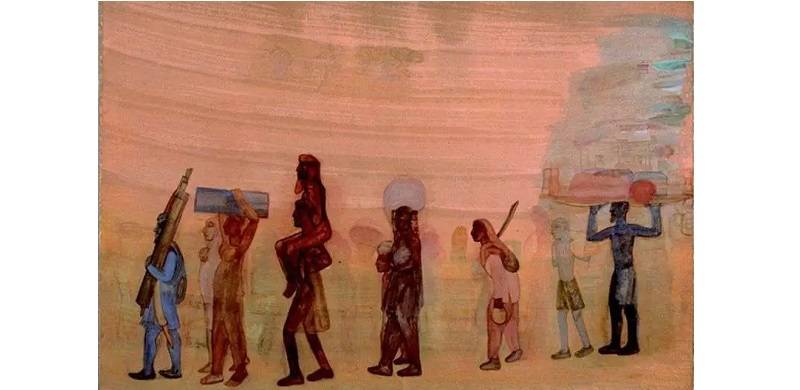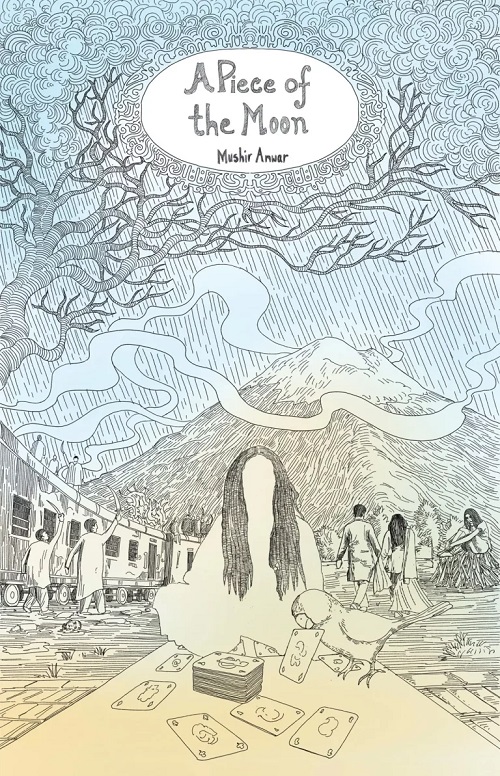
Once in a while, a novel comes along that captures your imagination and enthralls you. But if anyone were to ask you what the story is, or how the plot progresses, you would be at a loss to answer. You have just spent time lost in the prose and enjoying the wordplay and the character sketches. A Piece of the Moon by Mushir Anwar is one such book. A remarkable first novel, by an author who passed away some years ago without seeing his manuscript in print, the novel could have slipped between the cracks and never seen the light of day. But the dedicated efforts of Mushir sahib’s son Khayyam, and some of his friends, ensured that it was edited and published earlier this year, and even featured in the Karachi Literature Festival.
A Piece of the Moon follows the trials and tribulations of an Indo-Pakistani clan, the family of Maulvi Najibullah and Beejan, as they navigate the 1947 Partition, love and loss, family intrigues, and of course, churails and the Forces which shape their lives in unexpected ways. The novel is not linear, and the many characters move through a time and space which folds into itself. But in the last few chapters, there is a conclusion of sorts.
Anwar starts the novel with a series of “self-portraits” where the characters introduce themselves in the first person. But even before this, the narrator has a few words to say, which set the tone for the whimsical tale that follows. To quote “[…] when the narrative comes alive and the characters seize power, both the narrator and the author lose control. The story becomes self propelling.” According to Anwar, the story, the character and the events are “adrift like flotsam.” The narrator tries to channel them into a particular path, but does not always succeed.
Nevertheless, the self-portraits are quite structured and provide a context for each of the main characters. There’s Dillan – the closest we come to a “main” character in this book, who first falls in love as a five-year-old on a train from Moradabad to Rampur, and then, only a short while later, witnesses trains pulling into the station with badly mutilated bodies on board: victims of the Partition frenzy. His father, an officer in the railway, arranges safe passage for his family across the border. There’s Uncle Ghafoor or Baray Mamoon, Dillan’s great uncle, who elaborates how relationships are important in Indian culture – to the extent that each relationship (mother or father’s brother, sister, etc.) is given a specific name. There is Apa, Dillan’s grandmother, ahead of her times for having been divorced and then happily remarried. And many others – Chotay Mamoon or Shaukat, the unlettered romantic; Shammo the Ahmadi girl who plays a key role in Dillan’s life; Anees and Chiddhan the house help. They all have their say here.
Once the characters have been introduced, they are set adrift so to speak, and they appear and disappear, sometimes in full chapters and sometimes in short vignettes throughout the book. We know from Baray Mamoon’s letters that Dillan is now an adult and living in England. And soon Dillan appears on a bus traveling from Turkey to Iran and through to Pakistan in the company of Shammo.
Their backstories emerge in short bursts. How the two families, one from Moradabad and Sunni and the other Punjabi Ahmadi, are nevertheless tied together through kinship and because the Punjabi branch offered shelter to the migrants amidst the upheaval of 1947 (and there is a remarkable dialogue here between Dillan and Shammo’s fathers on what Pakistan meant to migrants, and to those who were already living in Muslim majority areas). How the Ahmadi family subsequently shifted to England after the Second Amendment, and found a suitable match for their daughter in a convert to their faith. But the best laid plans often come to nought and so it is with Dillan and Shammo. For Shammo must follow her heart and Dillan must do his duty. Which includes keeping up with the vicissitudes faced by his family, not least the slow degeneration of the Piece of the Moon herself, Attiya Bi.
Overall, the novel is a collection of tales, a series of story arcs, often narrated in a non-linear form. But the reader remains in the grip of the author because of the writing itself. There are insights into history and politics, amusing observations, empathetic character studies, heartbreak, love and loss, all in captivating prose. A Piece of the Moon should be read and enjoyed by fiction lovers across the Subcontinent.
A Piece of the Moon follows the trials and tribulations of an Indo-Pakistani clan, the family of Maulvi Najibullah and Beejan, as they navigate the 1947 Partition, love and loss, family intrigues, and of course, churails and the Forces which shape their lives in unexpected ways. The novel is not linear, and the many characters move through a time and space which folds into itself. But in the last few chapters, there is a conclusion of sorts.
Anwar starts the novel with a series of “self-portraits” where the characters introduce themselves in the first person. But even before this, the narrator has a few words to say, which set the tone for the whimsical tale that follows. To quote “[…] when the narrative comes alive and the characters seize power, both the narrator and the author lose control. The story becomes self propelling.” According to Anwar, the story, the character and the events are “adrift like flotsam.” The narrator tries to channel them into a particular path, but does not always succeed.

Book: A Piece of the Moon
Author: Mushir Anwar
Publisher: Folio Books, February 2023
Nevertheless, the self-portraits are quite structured and provide a context for each of the main characters. There’s Dillan – the closest we come to a “main” character in this book, who first falls in love as a five-year-old on a train from Moradabad to Rampur, and then, only a short while later, witnesses trains pulling into the station with badly mutilated bodies on board: victims of the Partition frenzy. His father, an officer in the railway, arranges safe passage for his family across the border. There’s Uncle Ghafoor or Baray Mamoon, Dillan’s great uncle, who elaborates how relationships are important in Indian culture – to the extent that each relationship (mother or father’s brother, sister, etc.) is given a specific name. There is Apa, Dillan’s grandmother, ahead of her times for having been divorced and then happily remarried. And many others – Chotay Mamoon or Shaukat, the unlettered romantic; Shammo the Ahmadi girl who plays a key role in Dillan’s life; Anees and Chiddhan the house help. They all have their say here.
Once the characters have been introduced, they are set adrift so to speak, and they appear and disappear, sometimes in full chapters and sometimes in short vignettes throughout the book. We know from Baray Mamoon’s letters that Dillan is now an adult and living in England. And soon Dillan appears on a bus traveling from Turkey to Iran and through to Pakistan in the company of Shammo.
Their backstories emerge in short bursts. How the two families, one from Moradabad and Sunni and the other Punjabi Ahmadi, are nevertheless tied together through kinship and because the Punjabi branch offered shelter to the migrants amidst the upheaval of 1947 (and there is a remarkable dialogue here between Dillan and Shammo’s fathers on what Pakistan meant to migrants, and to those who were already living in Muslim majority areas). How the Ahmadi family subsequently shifted to England after the Second Amendment, and found a suitable match for their daughter in a convert to their faith. But the best laid plans often come to nought and so it is with Dillan and Shammo. For Shammo must follow her heart and Dillan must do his duty. Which includes keeping up with the vicissitudes faced by his family, not least the slow degeneration of the Piece of the Moon herself, Attiya Bi.
Overall, the novel is a collection of tales, a series of story arcs, often narrated in a non-linear form. But the reader remains in the grip of the author because of the writing itself. There are insights into history and politics, amusing observations, empathetic character studies, heartbreak, love and loss, all in captivating prose. A Piece of the Moon should be read and enjoyed by fiction lovers across the Subcontinent.

